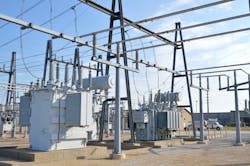Electric Utilities’ Power Play Could Chip Away at CSPs $$$
Power and telecommunications have been synergistic since wires have been attached to wooden poles. Over time, those poles became jointly owned and monies were exchanged if work was required by one entity that required activity by the other. Moreover, when a third party wanted to attach to these poles, payment was required to both pole owners.
As power grids advanced, telecommunications became a necessity to connect substations and control centers for electric utilities’ Supervisory Control and Data Acquisition (SCADA) applications. As the needs for monitoring and device communications increased, so did costs for these services by telecommunications companies. Consequently, many power companies invested in their own private telecommunications systems.
Many power utilities have built radio, wireless, copper wire, and most recently, fiber telecom infrastructures. The costs of the private networks paid for themselves in three to five years depending on the circumstance. With their private infrastructure, power companies could update the systems, add termination and drop points without the cost they were previously paying to the carriers. Of course, they also needed internal resources to build and maintain these networks—networks that were foreign to existing power company employees.
“Telecom networks have evolved from a non-necessity to a revenue driver for the utilities. This could easily be the solution to the dwindling revenue in the utility space depending on the jurisdictional rules within the targeted geography.”
Today, the power companies are designing and building ringed diverse fiber networks that could be superior to those of telecom companies from diversity and reliability perspectives. The networks are built with multiple year fiber needs in mind. With power companies, being the sole utility that currently serves every household and every business, the opportunities are endless. These sophisticated and highly diverse ringed networks have the bandwidth to easily serve their own telecommunications needs and the ability to lease fibers to others. Additionally, the networks are sophisticated and robust and can provide services to households, depending on local legislation. These modern fiber footprints can provide bountiful revenue streams for the utilities, provided they have the vision and foresight to put such opportunistic plans in action.
The Devil’s in the Deployment Details
The key consideration remaining for utilities is deciding upon the most cost-effective fiber network to build, keeping in mind that this is truly a state-of-the-art telecom network, not a power infrastructure they are accustomed to creating.
There are two networks under consideration:
- The first is a multi-tiered ring design. This involves ringing a group of substations together then creating “feeder rings” within each substation’s serving area that is essentially an overlay of the existing feeder routes. Still, pole and conduit space restrictions can hinder progress and have the potential to drive up costs. However, this creates a ring redundancy and allows for devices (e.g., reclosers, DA devices, and other smart grid devices) to communicate directly to one another instead of communications going back to a substation then rerouted to the correct device.
- The second is a Gigabit Passive Optic Network (GPON) design. This involves placing an Optical Line Terminal (OLT) in the substation. Then there is the decision to utilize centralized fiber splitting or distributed fiber splitting, which could be an article unto itself. Either will work for utility provider purposes but decisions on Centralized vs. Distributed should be made based on long-term utilization plans. The final step is to install an Optical Network Terminal (ONT) to each end user service from the ONT. While both infrastructure designs provide phenomenal, redundant fiber solutions for the utilities, GPON, if designed correctly, can allow for greater diversity with less cost.
Unfortunately, the cost of labor for fiber placement and splicing is the limiting factor in many cases. The ring inside a ring design requires many more labor hours to install and splice the fiber. For example, when installing a GPON network, you could run a 48 fiber from the OLT to the fiber split location. With a 1:32 splitter, you could have 5 x 216 cables coming out of the split location to feed all devices in five different feeders, or you could feed all devices in five feeders and provide fiber to all the households in that area to provide triple play services. The devil is in the details, as we know.
Telecom networks have evolved from a non-necessity to a revenue driver for the utilities. This could easily be the solution to the dwindling revenue in the utility space depending on the jurisdictional rules within the targeted geography.
As we enter a purely digital world, grid technology is slowly following. New technologies bring accuracy, speed, decreased costs, and increased capabilities. As with anything, however, the benefits come at a price. Networked systems present an opportunity for cyberattacks, new testing methods need to be adopted, and there must be continuous improvement of storage and logic settings for every Intelligent Electronic Device (IED).
If recent history tells us anything, the modern electric grid will be 100% digital and smart. The real question is, how long before electric utilities and telecom providers leverage their combine strengths in a mutually beneficial model?
ABOUT THE AUTHOR
Joe Hadsell is the Telecommunications Section Manager at Milhouse Engineering and Construction, Inc. He is an accomplished, result-driven program and project management leader with 35 years of experience in the telecom and fiber optics industries. For more information, please email [email protected] or visit www.milhouseinc.com. Follow them on Twitter @milhouseinc and LinkedIn: company/milhouse-engineering-and-construction-inc.
About the Author
Joe Hadsell
Telecommunications Section Manager, Milhouse Engineering and Construction, Inc.
Joe Hadsell is the Telecommunications Section Manager at Milhouse Engineering and Construction, Inc. He is an accomplished, result-driven program and project management leader with 35 years of experience in the telecom and fiber optics industries. For more information, please email [email protected] or visit www.milhouseinc.com. Follow them on Twitter @milhouseinc and LinkedIn: company/milhouse-engineering-and-construction-inc.


